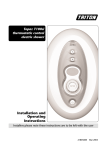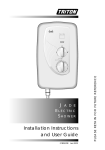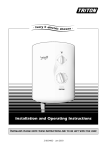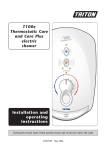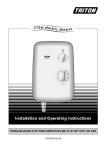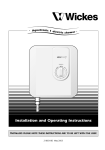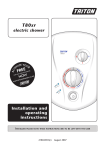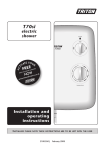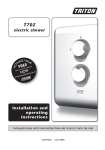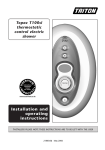Download Installation and Operating Instructions
Transcript
. T300si electric shower . 300si Installation and Operating Instructions INSTALLERS PLEASE NOTE THESE INSTRUCTIONS ARE TO BE LEFT WITH THE USER 2180280B Jan 00 T300si CONTENTS Page Important safety information 1 Introduction 2 Advice to users 2 Key to main components 3 Electrical requirements 4-5 Water requirements 6 Siting of the shower 6-7 Fitting the power pack 8 Plumbing connections 9 - 11 Fitting the bulkhead 12 Electrical connections 13 Fitting the control panel bracket 14 Fitting the control panel 15 Fitting the power pack cover 15 Commissioning 15 - 16 Fitting the riser rail 17 Fitting the hose and sprayhead 18 Operating the shower 19 - 20 Operating functions 21 Adjusting the sprayhead 22 User maintenance 23 Spare parts 24 - 26 Fault finding 27 - 28 Temperature/flow rate graph inside rear cover Guarantee, service policy, etc. rear cover To ensure the product suitability for commercial and multiple installations, please contact Triton’s specification advisory service prior to installation. Telephone: (024) 7632 5491 Facsimile: (024) 7632 4564 E mail: [email protected] T300si PLEASE READ THIS IMPORTANT SAFETY INFORMATION ◆ Products manufactured by Triton are safe and without risk provided they are installed, used and maintained in good working order in accordance with our instructions and recommendations. ◆ DO NOT operate shower if frozen, or suspected of being frozen. It must thaw out before using. ◆ DO NOT operate the unit if the sprayhead or spray hose becomes damaged. ◆ DO NOT restrict flow out of the shower by placing sprayhead in direct contact with your body. ◆ DO NOT operate the shower if water ceases to flow during use or if water has entered inside the unit because of an incorrectly fitted cover. 2.4 DO NOT fit any form of outlet flow control as the outlet acts as a vent for the heater can. 2.5 DO NOT use excessive force when making connections to the flexible hose or sprayhead, finger tightness is sufficient. 2.6 All plumbing connections MUST be completed BEFORE making the electrical connections. 3 ELECTRICAL 3.1 The installation must comply with BS 7671 ‘Requirements for electrical installations’ (IEE wiring regulations) or any particular regulations as specified by the local Electrical Supply Company. 3.2 This appliance MUST be earthed. 3.3 In accordance with ‘The Plugs and Sockets etc. (Safety) Regulations 1994’, this appliance is intended to be permanently connected to the fixed wiring of the electrical mains system. 3.4 Ensure all electrical connections are tight to prevent overheating. 3.5 Fuses do not give personal protection against electric shock. 3.6 To enhance electrical safety a 30mA residual current device (RCD) should be installed in all UK electric and pumped shower circuits. This may be part of the consumer unit or a separate unit. 3.7 Switch off immediately at isolating switch if water ceases to flow during use. 3.8 Other electrical equipment i.e. extractor fans, pumps must not be connected to the circuits within the unit. 3.9 Switch off at isolating switch when not in use. This is a safety procedure recommended with all electrical appliances. 3.10 As with all electrical appliances it is recommended to have the shower and installation checked at least every two years by a competent electrician to ensure there is no deterioration due to age and usage. 1 GENERAL 1.1 Isolate the electrical and water supplies before removing the cover. 1.2 Read all of these instructions and retain them for later use. 1.3 DO NOT take risks with plumbing or electrical equipment. 1.4 Isolate electrical and water supplies BEFORE proceeding with the installation. 1.5 The unit must be mounted onto the finished wall surface (on top of the tiles). DO NOT tile up to unit after fixing to wall. 1.6 Contact Customer Service (see back page), if any of the following occur; a) If it is intended to operate the shower at pressures above the maximum or below the minimum stated. b) If the unit shows a distinct change in performance. c) If the shower is frozen. 1.7 If it is intended to operate the shower in areas of hard water (above 200 ppm temporary hardness), a scale inhibitor may have to be fitted. 1.8 The sprayplate and cartridge must be cleaned regularly with descalent to remove scale and debris, otherwise restrictions to the flow on the outlet of the unit will result in higher temperatures and could also cause the Pressure Relief Device in unit to operate. 1.9 This product is not suitable for mounting into steam rooms or steam cubicles. 2 PLUMBING 2.1 The plumbing installation must comply with Water Regulations, Building Regulations or any particular regulations as specified by Local Water Company or Water Undertakers and should be in accordance with BS 6700. 2.2 The supply pipe must be flushed to clear debris before connecting to the shower unit. 2.3 DO NOT solder pipes or fittings within 300mm of the shower appliance, as heat transfer can damage components. 1 T300si ADVICE TO USERS INTRODUCTION The following three points will help you understand how the shower operates: This book contains all the necessary fitting and operating instructions for your Triton T300si electric shower – please read them carefully. 1 The electric heating elements operate at a constant rate at your chosen power setting. It is the flow rate of the water passing through the heater unit which determines the shower temperature at any given setting. (The slower the flow the hotter the water becomes, and the faster the flow the cooler the water). The shower installation must be carried out by a suitably qualified person and in the sequence of this instruction book. Care taken during the installation will ensure a long, trouble-free life from your shower. SPECIFICATIONS Electrical Nominal power rating at 240V Nominal power rating at 230V 8.5kW – (40A MCB rating) 9.5kW – (40A MCB rating) 7.9kW – (40A MCB rating) 8.8kW – (40A MCB rating) 2 During the Winter the cold water supply will be cooler than in the Summer months. Therefore, the temperature of the water will vary from season to season on any one setting of the control buttons, e.g. if you have chosen 'Economy' power for your preferred shower temperature in the Summer, you will have to select the 'High' setting and adjust the temperature control during the Winter months (refer to temperature/flow rate graph on inside of rear cover). Water Inlet connection – 15mm diameter. Outlet connection – 1/2” BSP male thread. Entry Points Water – bottom or back. Cable – top or back. 3 The stabiliser valve minimises variations in shower temperature during mains water pressure changes. If changes in shower temperature are experienced during normal use, it will most likely be caused by the water pressure falling near to or below the minimum level. The drop in pressure may be due to water being drawn off at other points in the house whilst the shower is in use. If pressure drops appreciably below the minimum, the heating elements will automatically cut out. Materials Backplate, cover, controls, sprayhead – ABS. Sprayplate – Acetal. Elements – Minerally insulated corrosion resistant metal sheathing. Dimensions control panel Height 235 mm Width 180 mm Depth 40 mm power pack 338 mm 208 mm 98 mm If ever the water becomes too hot and you cannot obtain cooler water, first check that the sprayhead cartridge has not become blocked. Standards and Approvals Product conforms to EN 60335-2-35 and splashproof rating IPX4. Complies with the requirements of current British and European safety standards for household and similar electrical appliances. Replacement parts can be ordered from Triton Customer Service. See ‘spare parts’ for details and part numbers. Complies with requirements of the British Electrotechnical Approvals Board (BEAB). Meets with Compliance with European Community Directives (CE). Important: When first installed (or following replacement of the PRD), the unit will be empty. It is essential the heater assembly contains water before the elements are switched on. As this unit has electronic control, it is vital that the commissioning procedure is followed on page 15. Failure to carry out this operation will result in damage to the unit and will invalidate the guarantee. Due to continuous improvement and updating, specification may be altered without prior notice. 2 T300si KEY TO MAIN COMPONENTS Power pack (fig.1) 1 Fig.1 17 Top cable entry 2 Bottom pipe entry 3 Rear pipe entry area 4 Rear cable entry area 5 Wall screw fixing 6 Terminal block 7 Printed circuit board 8 Stabilising valve 9 Solenoid valve 10 Mains cable clamp 11 Can and element assembly 12 Thermal safety cut-out (main) 13 Earth connection 14 Control cable clamp 15 Thermal cut-out (outlet) 16 Outlet pipe 17 Guide pockets 18 Transformer 19 Connector socket 20 Stepper motor 5 Control cable exit Access plate 19 145 mm 6 7 11 4 10 13 8 338 mm 5 20 14 9 Inlet 47 mm 15 3 17 68 mm 2 16 Outlet 22 1 12 Control panel (fig.1a) 21 17 18 208 mm Pack contents Control panel Power pack Sprayhead kit Bulkhead Riser rail, soap dish and fittings Heated water tube (white) 22 PRD tube (clear) Flexible hose 21 Connecting cable Plumbing connection kit Fixing kit Fig.1a Instructions, guarantee, template etc. 3 T300si ELECTRICAL REQUIREMENTS WARNING THIS APPLIANCE MUST BE EARTHED The installation, supply cable and circuit protection must conform with IEE wiring regulations and be sufficient for the amperage required. The following notes are for guidance only: 1 The shower must only be connected to a 230/240V ac supply. If you are installing a shower with a kilowatt rating above 9kW, it is advisable to contact the local electricity supply company. 1.1 The electrical rating of the shower is shown on the rating label within the unit. 2 Before making any sort of electrical connection within the installation, ensure that no terminal is live. If in any doubt, switch off the whole installation at the consumer unit. 3 The shower must be connected to its own independent electrical circuit. IT MUST NOT be connected to a ring main, spur, socket outlet, lighting circuit or cooker circuit. Fig.2 schematic of installation circuit 3.1 The electrical supply must be adequate for the loading of the unit and existing circuits. 4 Check your consumer unit (main fuse box) has a main switch rating of 80A or above and that it has a spare fuse way which will take the fuse or mcb necessary for the shower (fig.2). 4.1 If your consumer unit has a rating below 80A or if there is no spare fuse way, then the installation will not be straight forward and may require a new consumer unit serving the house or just the shower. 4.2 You will need to contact the local electricity company. They will check the circuit and carry out what is necessary. They will also check the main bonding. 5 The earth continuity conductor of the electrical installation must be effectively connected electrically to all exposed metal parts of other appliances and services in the room in which the shower is to be installed, to conform to current IEE regulations. 5.1 All exposed metallic parts in the bathroom must be bonded together using a cable of at least 4mm2 cross sectional area. These parts include metal baths, radiators, water pipes, taps and waste fittings. Pull cord isolating switch Table A Power pack RCD (can be part of consumer unit) CIRCUIT PROTECTION Control panel Fuse or mcb Consumer unit Meter Incoming supply fuse 80A or 100A main switch Meter tails 4 unit rating mcb cartridge fuse 7.0kW 30/32A 30A 7.5kW 32A 35A 8.0kW 40A 35A 8.5kW 40A 45A 9.0kW 40A 45A 9.5kW 40/45A 45A 10.5kW 45A 45A T300si ELECTRICAL REQUIREMENTS 6 For close circuit protection DO NOT use a rewireable fuse. Instead use a suitably rated miniature circuit breaker (MCB) or cartridge fuse (see table A). 6.1 In the interest of electrical safety a 30mA residual current device (RCD) should be installed in all UK electric and pumped shower circuits. This may be part of the consumer unit or a separate unit. 7 A 45 amp double pole isolating switch with a minimum contact gap of 3mm in both poles must be incorporated in the circuit. 7.1 It must have a mechanical indicator showing when the switch is in the OFF position. 7.2 The wiring must be connected to that switch without the use of a plug or socket outlet. 7.3 The switch must be readily accessible and clearly identifiable, but out of reach of a person using a fixed bath or shower. 7.4 If the isolating switch is to be fitted in the bathroom, then it must be a cord operated type and should be placed so that it is not possible to touch the switch body when standing in a bath or shower cubicle. Twin and earth PVC insulated cable clipped direct or buried in a non insulated wall 6mm2 6mm2 6mm2 32A 38A 46A 10mm2 10mm2 10mm2 43A 52A 63A 16mm2 16mm2 16mm2 57A 69A 85A 8 Where shower cubicles are located in rooms other than bathrooms, any socket outlet in that room must be situated at least 2.5 metres from the shower cubicle. 9 The current carrying capacity of the cable must be at least that of the shower circuit protection (see table B). 9.1 To obtain full advantage of the power provided by the shower, use the shortest cable route possible from the consumer unit to the shower. 9.2 It is also necessary to satisfy the disconnection time and thermal constraints which mean that for any given combination of current demand, voltage drop and cable size, there is a maximum permissible circuit length. 10 The shower circuit should be separated from other circuits by at least twice the diameter of the cable or conduit. 10.2 In the majority of installations, the cable will unavoidably be placed in one or more of the above conditions. This being so, it is strongly recommended to use a minimum of 10mm cabling throughout the shower installation. CURRENT CARRYING CAPACITY in conduit or trunking Preferably it should be outside the shower enclosure and be readily accessible in order to switch off after using the shower. 10.1 The current rating will be reduced if the cabling is bunched with others, surrounded by thermal loft or wall insulation or placed in areas where the ambient temperature is above 30°C. Under these conditions, derating factors apply and it is necessary to select a larger cable size. Table B installed in a insulated wall 7.5 10.3 In any event, it is essential that individual site conditions are assessed by a competent electrician in order to determine correct cable size and permissible circuit length. Note: Cable selection is dependent on de-rating factors 5 T300si WATER REQUIREMENTS Mains electric supply (via double pole switch) The installation must be in accordance with Water Regulations/Byelaws. To ensure activation of the heating elements, the shower must be connected to a mains water supply with a minimum running pressure of 1.0 bar (14.5 p.s.i.) at a minimum flow rate of 9 litres per minute and a maximum static pressure of 10 bar (145 p.s.i.). NOTE: If the stated flow rate is not available, it may not be possible to achieve optimum performance from the unit throughout the year. Control Panel Double pole isolating switch The water supply can be taken from a cold water storage cistern provided there is a minimum head of 10 metres. (i.e. the vertical distance from the base of the cistern to the sprayhead). It must be an independent supply to the shower only. Power Pack Control cable Heated water pipe Isolating stopvalve Mains water supply If it is intended to operate the shower at pressures above the maximum or below the minimum stated, contact Triton Customer Service for advice. Separate permanently connected supply from consumer unit Figure 3 shows a typical system layout. SITING OF THE SHOWER Fig.3 Diagrammatic view (not to scale) WARNING: THE SHOWER MUST NOT BE POSITIONED WHERE IT WILL BE SUBJECTED TO FREEZING CONDITIONS. FOR EASE OF SERVICING, THE CONTROL PANEL MUST ALWAYS BE MOUNTED ON THE SURFACE OF TILED WALLS. NEVER TILE UP TO THE UNIT. Control cable The power pack must be positioned within 3.5 meters (11 ft.) of cable and pipe run from the control panel and bulkhead. Height of sprayhead to suit user's requirement Control panel must not be within 1 metre from base Soap dish retaining ring WARNING: Under no circumstance should the control cable be extended or shortened, or the heated water pipe be extended. This will impair the performance of the shower and also invalidate the guarantee. NOTE: The control cable is supplied with protective dust covers fitted at either end. DO NOT remove them until all installation work is complete and ready for the final connection to the control panel and power pack. Bulkhead can be mounted either side of riser rail Heated water pipe 25 mm minimum Mains cold water supply. Bottom entry can be surface mounted. All other entries must be from rear. Refer to figure 4 for correct siting of shower. Position the control panel where it will NOT be in direct contact with water from the sprayhead. Position the power pack vertically and accessible for maintenance purposes. Spillover level Outline of bath or shower tray Fig.4 Diagrammatic view (not to scale) 6 T300si NOTE: Water Regulations require that the sprayhead be ‘constrained by a fixed or sliding attachment so that it can only discharge water at a point not less than 25mm above the spill-over level of the relevant bath, shower tray or other fixed appliance’. The use of the supplied soap dish will in most cases meet this requirement, but if the sprayhead can be placed within a bath, basin or shower tray, then a double check valve, or similar device, must be fitted in the supply pipework to prevent back-flow. Fig.5 Can PRD Pressure relief safety device A pressure relief device – PRD (fig.5) is designed into the shower unit which complies with European standards. The PRD provides a level of appliance protection should an excessive build up of pressure occur within the shower. If the PRD operates, then water will eject from the clear PRD tube, so ensure the tube, when eventually installed, is routed carefully to waste. Outlet pipe In the event of the PRD operating, turn off the electricity and water supplies to the shower at the isolating switch and stopvalve. Contact Customer Service for advice on replacing the PRD. Fig.6 DO NOT operate the shower with a damaged or kinked shower hose, or a blocked sprayhead which can cause the PRD to operate. When commissioning, the sprayhead must be removed from the flexible hose. If not removed, then again it may cause the PRD to operate. Routing control cable and heated water pipe After deciding the position of the riser rail and control panel, you may wish first to channel a route for the semi rigid heated water pipe and the control cable from the power pack position to the control panel and bulkhead position. The control cable must exit the shower cubicle wall through a 15mm hole – marked ‘B’ on the supplied fixing template (fig.6). Place the template on the wall and mark the position of the 15mm hole. Drill and channel a route as required. Place and position the control cable between the power pack and control panel. Ensure there is enough slack cable at the power pack end in order for the control panel to be removed should the need arise for future maintenance A A A A B Within the shower cubicle, the end of the control 7 T300si cable outer sleeve must be flush with the finished wall surface to allow easy installation, and the inner cable should be loose and able to slide through the outer sleeve when finally installing the control panel. It is advisable to seal the outer sleeve in the hole using a silicon seal. Fig.7 400mm approx Make good the wall, including any tiling, as all the units must be screwed to the finished wall surface. Important: In the shower area the control cable linking the power pack and control panel must be secured by routing through conduit, trunking or capping if embedding in the wall. It must not be surface clipped. 250mm approx FITTING THE POWER PACK Important: The power pack must be mounted on a flat surface which covers the full width and length of the backplate. It is important that the wall surface is flat otherwise difficulty may be encountered when fitting the cover and subsequent operation of the unit may be impaired. Fig.8 The power pack must always be positioned so that there is easy access for installation and maintenance. Where this is difficult or a suitable wall is not available, a mounting bracket similar to that shown in fig.7 can be used. It must be positioned in a dry area, ideally in a linen or airing cupboard. It must be well ventilated and not covered with towels, sheets etc. Important: The power pack MUST be mounted vertically. DO NOT MOUNT IT HORIZONTALLY. Procedure: Unscrew the top and bottom retaining screws (fig.8) and lift cover from the backplate. To facilitate the pipe and cable connections, remove the two screws (fig.9) and take off the trimplate. Fig.9 After choosing the site for the shower, use the backplate as a template and mark two fixing holes (fig.10). Drill and plug to suit the fixing screws supplied. Screw top fixing screw into position leaving the base of the screw head protruding 6mm (0.25in) out from the wall. Entry positions for the mains water are from the bottom or from the rear. Cable entry is via the top or rear. 8 T300si NOTE: Deviations from the designated entry points will invalidate product approvals. Fig.10 If a bottom surface entry is required for the mains cold water then the necessary hole will need to be cut out in the trimplate and cover (fig.11). If a surface cable entry from the top is required then the relevant hole in the backplate will need to be cut out (fig.12). Hook the backplate over the top screw and fit the bottom fixing screw into position. Do not fully tighten the screws at this stage, as the fixing holes are elongated to allow for out of square adjustment after the plumbing connections have been completed. PLUMBING CONNECTIONS Plumbing to precede wiring. WARNING: The outlet of the shower acts as a vent and must not be connected to any tap or fitting not recommended by Triton Plc. DO NOT use jointing compounds on any pipe fittings for the installation. DO NOT use soldered fittings within the vicinity of the shower unit. Compression fittings MUST be used to connect to the inlet of the power pack (push on fittings must not be used as the power pack inlet may not fully enter this type of fitting to provide a water tight seal). Fig.11 Bottom View remove NOTE: An additional stopvalve – complying with Water Regulations, MUST be fitted in the mains water supply to the power pack as an independent means of isolating the water supply should maintenance or servicing be necessary. ,,,,,,,, ,,,,,,,, ,,,,,,,, ,,,,,,,, ,,,,,,,, ,,,,,,,, ,,,,,,,, ,,,,,,,, Important: Before completing the connection of the water supply to the inlet of the power pack, flush out the pipework to remove all swarf and system debris. This can be achieved by connecting a hose to the pipework and turning on the mains water supply long enough to clear the debris to waste. Top View Fig.12 wall Procedure Turn off the water supply either at the mains stopvalve or the isolating stopvalve. Connect the mains water supply to the inlet of the power pack via a 15mm x 15mm elbow compression fitting (not supplied). ,,,,,, ,,,,,, ,,,,,, remove 9 T300si If installing a feed pipe from the rear or bottom, the centre of the inlet valve to the wall surface is 20mm. (fig.13). Fig.13 NOTE: If entry is from the rear, the nut of the compression fitting will be partially behind the surface of the wall (fig.13). This area must be left clear when plastering over the pipework in order to make the nut accessible for future adjustments. 20 mm Do not use excessive force when making these connections. It is strongly recommended to use a correct size open ended spanner. Using adjustable pipe grips may damage internal components. Ensure the backplate is square on the wall and tighten the two retaining screws which hold it to the wall. Turn on the mains water supply and check for leaks in the pipework connection to the power pack. NOTE: At this stage no water can flow through the unit. Fig.14 Copper pipe Grab ring Spacer ‘O’ ring Spacer Nut The power pack is connected to the bulkhead outlet by means of a semi rigid white 10mm plastic water pipe which carries the heated water. This pipe can be channelled in a wall, plumbed through a wall or hidden behind a studded wall. The pipe can be run up to 3.5m (11ft) away from the power pack. Any surplus can be cut off as required. NOTE: The water outlet does not need to be vertically above or below the control panel. If required the outlet adaptor and control panel can be placed on different walls as long as the control panel is not in the direct line of any spray when in use. Push on the fittings to both ends of the heated water pipe as follows: Heated water pipe Slide the nut over the water pipe (fig.14) followed by the ‘O’ ring sandwiched between the two spacers – ensure the spacers have their flat sides towards the ‘O’ ring. Push the grab ring onto the pipe so that it locates approximately 5 to 10mm from the end. Finally, insert the supplied 8mm copper pipe into the end of the water pipe until it is flush. This is to provide extra support to the plastic pipe. 10 T300si The pipe connects to the power pack using the outlet extension (fig.15) which is screwed onto the power pack outlet pipe. Alternatively a 1/2in x 15mm female thread to compression elbow can be screwed onto the outlet pipe, sealing the joint with PTFE tape. Fig.15 Outlet pipe Washer Fit the clear plastic PRD tube through the can outlet pipe boss situated at the rear of the outlet pipe (fig.16) and push firmly on to the PRD outlet. Outlet extension The other end of the PRD tube needs to be directed to a suitable and visible waste. NOTE: Check the correct tubes have been used as they are similar in diameter and length (the PRD tube is clear). Important: Do not bend either the PRD tube or heated water pipe sharply as they will kink and restrict the water flow. If a tight bend is required in the heated water pipe cut the pipe and rejoin with standard 10mm elbow compression fittings. Can PRD outlet Insert a 25mm (1in) length of 8mm copper pipe (4 are supplied, but more may be required) to provide support for the plastic pipe under the olive ring. If possible, the connections should be accessible so that adjustment can be carried out when required. Pipe boss Outlet pipe PRD tube THE POWER PACK MUST NOT BE SITED IN LOFT SPACES WHERE IT MAY BE SUBJECTED TO FREEZING CONDITIONS IN WINTER MONTHS OR HIGH AMBIENT TEMPERATURES DURING SUMMER MONTHS. IF MOUNTED IN AN AIRING CUPBOARD, ENSURE CLOTHING ITEMS ETC. DO NOT RESTRICT THE AIR FLOW AROUND THE POWER PACK. 11 Fig.16 T300si Fig.17 FITTING THE BULKHEAD Heated water pipe Route the heated water pipe to the outlet position and push on the fittings as shown in fig.14. Appropriate fitting e fac d she sur i Fin 8 - 13 mm Fig.18 Connect the heated water pipe to a 1⁄2" x 15mm male thread to compression elbow or straight connector with suitable thread length (fig.17). NOTE: This fitting is not supplied as variations in installations necessitates selection of the most appropriate fitting. Make good the wall. The bulkhead and its cover are supplied assembled. Separate the two halves by carefully prising apart at the smaller of the two elbow apertures. Fit the elbow to the bulkhead and secure with the three screws supplied (fig.18). Screw the bulkhead assembly onto the threaded fitting temporarily in order to mark the position of the two fixing holes (fig.19) for securing the bulkhead to the wall. Unscrew and remove the bulkhead. Check the location of the pipe in the wall before drilling. Fig.19 Drill and plug the holes using the wall plugs supplied or if fitting to a hollow wall structure, use suitable cavity wall fixings. Apply PTFE tape to the threaded fitting. Screw the bulkhead assembly onto the threaded fitting until tight to the wall and the two fixing holes are aligned. Secure to the wall with the two screws supplied (fig.20). Finally, finish by clipping the cover onto the bulkhead ensuring the protruding legs locate in the bulkhead body. Fig.20 12 T300si ELECTRICAL CONNECTIONS L N SWITCH OFF THE ELECTRICITY SUPPLY. Fig.21 shows a schematic wiring diagram. Fig.21 E 3 4 1 The cable entry points are shown in figure1. The cable can be surface clipped, hidden or via 20mm conduit. 2 5 NOTE: Conduit entry can only be from rear. Route the cable into the shower unit and connect to the terminal block (fig.22) as follows:- 7 6 8 Earth cable to terminal marked E Neutral cable to terminal marked N Live cable to terminal marked L IMPORTANT: Fully tighten the terminal block screws and ensure that no cable insulation is trapped under the screws. Loose connections can result in cabling overheating NOTE: The supply cable earth conductor must be sleeved. The outer sheath of the supply cable must be stripped back to just after the cable clamp (fig.22). 9 inlet outlet 11 The cable clamp (fig.22) is suitable for 6mm2 cable or can be reversed for 10mm2 cable. 10 If a cable larger than 10 mm2 is used, do not use the cable clamp but the cable must then be secured either by routing through conduit or in trunking or by embedding in the wall, in accordance with current IEE regulations. 1 2 3 4 5 6 The use of connections within the unit, or other points in the shower circuit, to supply power to other equipment i.e. extractor fans, pumps etc. will invalidate the guarantee. Terminal block T300si Earth post Transformer Motor Thermal cut-out (main) Control panel PCB 7 8 9 10 11 Power pack PCB Control cable Elements Solenoid valve Thermal cut-out (outlet) Fig.22 Terminal block WARNING: Under no circumstance should the control cable be extended or shortened, as not only will it impair the performance of the shower but will also invalidate the guarantee. Cable clamp NOTE: The elements on UK models are to 240V specification and will give a lower kW rating if the voltage supply is below 240V. 13 T300si FITTING THE CONTROL PANEL BRACKET Fig.23 Align the supplied fixing template (fig.6) with the 15mm control cable hole already drilled and mark the four fixing holes marked ‘A’ on the template. Drill and plug using the plugs supplied, or suitable cavity fixings. Using the screws supplied, secure the mounting bracket to the wall (fig.23). NOTE: The mounting bracket must be fitted on the surface of the tiles. The control panel is connected to the power pack by means of a supplied length of control cable complete with a plug at either end. Either end of the cable can be plugged to the power pack PCB (fig.24) or the control panel PCB. Fig.24 Socket for control cable Cable entry into the control panel is via the aperture on the back of the main body of the control panel. Remove the two screws and remove the access panel (fig.25) to reveal the connector socket. Cable entry into the power pack is through one of the built in cut-outs. Remove the protective dust covers from both ends of the control cable. Once the cable has been plugged into the socket inside the control panel, refit the access panel ensuring the cable exits through the slot at the bottom corner of the access panel (fig.26). Fig.25 Important: Sufficient free play should be left in the cable to enable future removal of the control panel for servicing purposes. Ensure the cable clamp in the power pack is used to secure the control cable (fig.27). DO NOT switch on the electricity supply until the cover on the power pack and control panel have been fitted. Fig.26 Control cable exit WARNING Under no circumstance should the control cable be extended or shortened, as not only will it impair the performance of the shower but will also invalidate the guarantee. 14 T300si FITTING THE CONTROL PANEL Fig.27 Hook the control panel over the lugs on the mounting bracket (fig.28) and slide down into place, ensuring the control cable does not get trapped. Secure in place with the single screw at the bottom of the control panel (fig.29). NOTE: To remove the panel once fitted, remove the single retaining screw, and lift off from the wall bracket lugs. Control cable clamp FITTING THE POWER PACK COVER Refit the trimplate and secure with the two screws. Before replacing the cover, check on the PCB that the purge pin is located on its two pins – the factory set position (see fig.31). Fig.28 Locate the tags on the cover into the holes on the backplate and guide into position. Secure the cover in position with the three retaining screws. NOTE: DO NOT FULLY TIGHTEN AT THIS STAGE AS THE POWER PACK COVER IS FITTED TEMPORARILY IN ORDER TO CARRY OUT THE COMMISSIONING PROCEDURE. COMMISSIONING WARNING: Before normal operation of the shower it is essential that the commissioning and purge pin procedures are correctly completed. The first operation of the shower is intended to flush out any remaining unit debris and to ensure the heater unit contains water before the elements are switched on. This operation must be carried out with the flexible hose screwed to the bulkhead outlet but without the sprayhead attached. Fig.29 Ensure the outlet of the flexible hose is directed to waste. Partially turn on the water supply to the shower and then turn on the electricity supply to the shower at the isolating switch. The start/stop button surround immediately lights up and remains lit while all four LED indicators will light up in sequence alternating between the ‘high’, ‘economy’, ‘cold’ and ‘low pressure’. This flashing sequence lasts approximately 20 seconds. All lights will then extinguish except the start/stop 15 T300si surround indicating that power is on to the unit. Fig.30 Press the start/stop button (fig.30) and the ‘cold’ indicator will light, while at the same time the ‘low pressure’ indicator will flash. Water will commence to flow from the flexible hose. It will take approximately 30 seconds for a smooth flow of water to be obtained whilst air and any debris is being dispersed from the shower. When a smooth flow of water is achieved, turn the water supply fully on and allow it to run for about 2 minutes. Once the flushing out has been completed, press the start/stop button and then SWITCH OFF THE ELECTRICITY SUPPLY to the shower at the isolating switch. Fig.31 Purge pin procedure On the power pack, unscrew the top and bottom retaining screws (fig.8) again and remove the cover. The purge pin is located on the power pack PCB inside the unit (fig.31). Pull the pin off its two pins and, in order to store it for use at a later date, replace it on one of the pins. Replacing the power pack cover Locate the tags on the cover into the holes on the backplate and guide into position. Secure the cover in position with the three retaining screws. Switch the electric supply back on at the isolating switch. Once the installation of the riser rail is complete, the shower is ready for normal operation. 16 T300si Fig.32 WARNING: Check there are no hidden cables or pipes before drilling holes for wall plugs. Use great care when using power tools near water. The use of a residual current device (RCD) is recommended. FITTING THE RISER RAIL Decide the position for the rail on the wall within the shower area. Proceed as follows: Fig.33 A Offer one of the two brackets to the wall for the lower position only. Note there are three holes in the brackets but two screws will usually be sufficient. However, the centre hole must be used so mark this and either of the other two. Drill and plug the wall. Replace the bracket to the wall and secure to the wall with the screws supplied (fig.32). Locate the rail onto this lower bracket ensuring the rail engages fully on the bracket. Ensure the indent in the riser rail engages into the cut-out on the bracket end (fig.33). Fig.34 Fig.35 Lever Lever Saddle Spacer Saddle B Locate the second bracket on top of the rail. Again mark the centre hole plus one of the other two holes. Ensure the rail is vertical. Remove the bracket and rail. Drill and plug the wall. Slider/holder assembly Fig.36 C With the saddle, spacer and lever parts to hand, screw the saddle 2 or 3 turns into the lever (fig.34). Place the saddle and lever into the slider/holder assembly (fig.35) so that the holes align, then slide onto the rail (fig.36). Tighten to the rail by turning the lever. When tight, the lever should be facing forwards and not pointing to the wall. If not, slacken off and remove from the rail. Rotate the saddle and lever 180° within the slider/holder assembly then replace onto the rail and tighten. Ensure the tapered thin end of the spray head holder is in the uppermost position. Tapered thin end Fig.37 Fig.38 D Place the rail onto the installed lower bracket. Replace the upper bracket onto the rail and secure the bracket to the wall with the screws supplied (fig.37). E Place a trim cover onto each bracket ensuring the large protrusion at the narrow end of the trim cover, engages into the slot between the rail and bracket (fig.38) before pushing and clicking the other end into place (fig.39). Fig.39 17 T300si Fig.41 Fig.40 Thin section at top Should the need arise, the trim covers can be removed by inserting a screwdriver into the slot and carefully levering off the trim. F Snap the soap dish onto the rail (fig.40) below the holder assembly. Prise open the soap dish collar and fit onto the rail (fig.41) below the dish. Note the collar is slightly tapered and should be fitted ‘thinner section’ uppermost. Ensure it locates firmly in the soap dish (fig.42) so that it holds the dish at the required height on the rail. FITTING THE HOSE AND SPRAYHEAD Fig.42 Fig.43 Feed the flexible hose through the appropriate soap dish aperture (fig.43) in order that the dish acts as a retaining ring (in compliance with Water Regulations). Screw the flexible hose to the shower outlet (if not already done) and sprayhead (fig.44) ensuring the supplied washers are in place at both ends of the flexible hose. Collar Fig.45 Fig.44 Place the sprayhead into the holder (fig.45) and check that it fits correctly. NOTE: The holder is slightly tapered and the sprayhead and hose will only fit from one direction. Important: It is the conical end of the hose which grips into the holder. The sprayhead will not fit in the holder without the hose attached. Sprayhead Shower Washers Sprayhead Holder 18 T300si OPERATING THE SHOWER Fig.46 Important: Ensure the commissioning procedure has been carried out. Failure to do so will damage the unit and invalidate the guarantee. When the electricity supply to the shower is switched on via the double pole isolating switch, the start/stop button surround immediately illuminates and remains illuminated while the shower runs through a start-up routine. All four LED indicators will light up in sequence alternating between the ‘high’, ‘economy’, ‘cold’ and ‘low pressure’. This flashing sequence lasts approximately 20 seconds and will occur every time the power is switched on at the isolating switch. All lights will extinguish except the start/stop surround indicating that power is on to the unit. The shower is now ready for normal operation. High power button 300si Economy power button Cold only button To start the shower Press the start/stop button and immediately the high button LED will light and water will commence to flow. To stop the shower Press the start/stop button. The phased shutdown will commence and water will cease to flow after a few seconds. Note the button surround will still be lit. Temperature control To use the control buttons There are three control buttons (high, cold and economy) as shown in fig.46. The upper button is a high power setting which allows the highest flow achievable for your preferred temperature. This setting should normally be regarded as optimum shower performance throughout the year. Temperature adjustment at this setting is via the temperature control. Start/stop button The centre button is an economy setting for using less power when the ambient mains water temperature is high during hot months. Temperature adjustment at this setting is via the temperature control. NOTE: If the stated flow rate required for the unit cannot be met due to low water pressure, it will be necessary to operate the unit on this setting during the warmer months because of flow rate limitations entering the unit. WARNING After any servicing of mains water supply, always ensure the unit is started on COLD in order to purge any air in the pipework. The lower button is for cold water only. 19 T300si Fig.47 Adjustment of the temperature control at this setting will only increase or decrease the force of the water from the sprayhead. (It will not alter the water temperature). To adjust the shower temperature The water temperature is altered by increasing or decreasing the flow rate of the water through the shower via the temperature control (fig.46). After obtaining your preferred showering temperature, the number can be remembered and left as the normal setting and should only need to be altered to compensate for seasonal changes in ambient water temperature. NOTE: The preferred number on ‘economy’ will give a different temperature to the same number position on ‘high’. Fig.48 To decrease the shower temperature Turn the temperature control anti-clockwise (fig.47). This will increase the flow of water through the shower and is indicated by lower numbers. To increase the shower temperature Turn the temperature control clockwise (fig.48). This will decrease the flow of water through the shower and is indicated by higher numbers. CAUTION: It is advisable to be certain that the showering temperature is satisfactory by testing with your hand before stepping under the sprayhead. There will always be a time delay of 10 to 15 seconds between selecting a flow rate and the water reaching the stable temperature for that flow rate. It is recommended that persons who may have difficulty understanding or operating the shower controls should not be left unattended whilst showering. Special consideration should be given to young children and the less able bodied. 20 T300si OPERATING FUNCTIONS Fig.49 Power on indicator (fig.49) When the electricity supply to the shower is switched on at the isolating switch, the start/stop button surround will light. High power indicator Low pressure indicator (fig.49) If this indicator flashes, it means the water pressure has fallen below the minimum required for correct operation of the shower, resulting in the low pressure cut-out operating. This switches off power to the heating elements preventing any maintained temperature rises (water will continue to flow) while at the same time the ‘cold’ indicator will light. When adequate water pressure returns, the ‘low pressure’ and ‘cold’ indicators both extinguish and the power will automatically be restored to the previous power setting at the time of interruption. Selector mode indicators (fig.49) Adjacent to each control button there is an LED which illuminates when the button is pressed, visually indicating which shower mode is in operation. 300si Economy power indicator Cold only indicator Low pressure indicator Phased shutdown In use, when the start/stop button is pressed, power is switched off to the elements. Water continues to flow for a few seconds, flushing out any remaining hot water. This ensures the next immediate user will not receive a slug of hot water if standing under the sprayhead when starting the shower. NOTE: The shower should always be switched off in this manner prior to isolating at the double pole isolating switch. Overheat cut-out During normal operation if an overheat temperature is sensed, power to the elements will be reduced. Water will continue to flow. When the temperature has cooled sufficiently, power to the elements will be automatically restored to the previous setting at the time of interruption. Safety cut-out The unit is fitted with a non re-settable over-temperature safety device. In the event of abnormal operation which could cause unsafe temperatures within the unit, the device will disconnect the heating elements. It will require a visit from a qualified engineer to determine the nature of the fault and replace the safety device, once the unit has been repaired. 21 Power on indicator NOTE: IN NORMAL USE, IT IS IN ORDER TO LEAVE THE WATER SUPPLY PERMANENTLY ON TO THE SHOWER UNIT, BUT AS WITH MOST ELECTRICAL APPLIANCES, THE UNIT MUST BE SWITCHED OFF AT THE ISOLATING SWITCH WHEN NOT IN USE. T300si ADJUSTING THE SPRAYHEAD Fig.50 Four sprayhead patterns are available (fig.50). Adjustment is by turning the bezel on the sprayhead in either direction until the desired pattern is obtained. MAXI MAXI A full spray perfect for a relaxing shower. ULTRA A focused spray for a refreshing, satisfying shower. NEEDLE A tingling, fine spray for a highly invigorating shower. JET A concentrated spray for an exhilarating shower. ULTRA NEEDLE JET 22 T300si USER MAINTENANCE Fig.51 Removal tool It is recommended that the shower unit, riser rail, hose etc. be cleaned using a soft cloth and that the use of abrasive or solvent cleaning fluids be avoided. Cartridge It is advised before cleaning, that the isolation switch be turned off, thus avoiding accidental switching on of the shower. IT IS MOST IMPORTANT TO KEEP THE SPRAYHEAD CLEAN IN ORDER TO MAINTAIN THE PERFORMANCE OF THE SHOWER. The hardness of the water will determine the frequency of cleaning. Sprayplate Sprayplate and cartridge removal There is no need to remove the sprayhead from the hose. Fig.52 Using the removal tool supplied (fig.51), locate the three raised ’bosses’ into the three recesses in the sprayplate. Hold in firmly and twist anticlockwise (fig.52). This movement may turn the cartridge assembly as well until it reaches a ‘stop’. Hold the cartridge firmly and continue to twist anti-clockwise. Having loosened the sprayplate sufficiently, it can be unscrewed and removed completely (fig.53). To remove the cartridge, hold firmly and turn anti-clockwise until it unscrews from the sprayhead (fig.54). Fig.53 Clean the sprayplate and cartridge with a suitable brush or preferably leave them to soak overnight in a mild proprietary descalent. Ensure all traces of scale are removed and thoroughly rinse in clean water afterwards. Sprayplate Before replacing the sprayplate and cartridge, it is advisable to direct the hose and sprayhead to waste, turn the temperature control fully anticlockwise and press the ‘COLD’ button. This operation will flush out any loose scale deposits in the unit and sprayhead. Stop after approximately 30 seconds. Fig.54 Refit the sprayplate and cartridge by screwing both in clockwise. Use the tool to screw in the sprayplate tight. Cartridge WARNING Do not use ‘powerful’ abrasive or solvent cleaning fluids when cleaning the shower as they may damage the plastic fittings 23 T300si Ref. Description 1 1 2 4 mode sprayhead white chrome effect gold effect 22008250 22008230 22008240 Sprayhead holder chrome effect gold effect white 83306200 83306210 83306190 Brackets (pr.) chrome effect gold effect white 83306170 83306180 83306160 Riser rail chrome effect gold effect white 7042409 7042410 7042411 Flexible hose chrome effect gold effect white 22003970 22003980 22003960 Soap dish white 22008960 7 Power pack cover 85200030 8 Control panel assembly white chrome effect gold effect 87400020 87400010 87400030 2 3 4 5 5 3 6 4 6 7 8 300si 24 Part No. T300si Ref. Description 9 Part No. Inter-connecting cable 82300900 10 PRD tube (clear) 22001310 11 Heated water pipe (white) 22003770 12 Control panel mounting bracket 7012512 Bulkhead assembly white chrome effect gold effect 85500170 85500180 85500190 14 Thermal cut-out (main) 22008330 15 Heater can assembly 8.5kW 9.5kW 83306390 83306400 16 Terminal block 82200800 17 Transformer 22009170 18 PRD & ‘O’ ring 83301330 13 9 11 10 13 12 14 15 16 17 18 25 T300si Ref. Description 20 19 19 Stepper motor 82300170 20 Stabiliser valve assembly 82600780 21 Power pack PCB 7072570 22 Control panel PCB 7072569 23 Outlet pipe assembly 85000090 24 Trimplate 7051754 25 Solenoid valve 22005320 26 Mains cable clamp 7051673 27 Heated water pipe fittings kit 83304290 Outlet extension tube 72509540 Wire set 83306410 21 28 - 22 23 25 24 26 27 28 26 Part No. T300si FAULT FINDING Problem/Symptom Cause 1 Shower inoperable, no water flow. 1.1 Interrupted power supply. 1.2 Unit malfunction. 2 Water too hot. 2.1 Not enough water flowing through the shower. 2.2 Blockage in supply. 2.3 Increase in ambient water temperature. 3 Water temperature cycling hot/cool at intervals. 3.1 Heater cycling on outlet thermal cut- out. 4 Water too cool or 4.1 Too much flow. cold. 4.2 Water pressure below minimum stated on rating label. 4.3 Reduction in ambient water temperature. 4.4 Electrical malfunction. 5 Cold indicator light on and low pressure indicator light flashing. 5.1 Purge pin not placed correctly. 5.2 Low water pressure. Action/cure 1.1.1 Blown fuse or circuit breaker. Check supply. Renew or reset fuse or circuit breaker. If it fails again, consult a qualified electrician. 1.1.2 Power cut? Check other appliances and if necessary, contact local Electricity Supply Company. 1.2.1 Have unit checked. Ring Customer Service. 2.1.1 Increase the flow rate via temperature control. 2.1.2 Blocked sprayhead - clean or replace blocked sprayplate / cartridge. 2.2.1 Check if stop taps are fully open. Check if blockage in inlet filter. 2.3.1 Switch to economy power setting and readjust flow rate to give required temperature. 3.1.1 See 'Water too hot' causes 2.1, 2.2 and 2.3 and their appropriate action/cures. If it continues, contact Customer Service. 4.1.1 Reduce the flow rate via temperature control. 4.2.1 Check low pressure indicator. If lit, continue with remainder of checks. If not lit, see 4.1 & 4.4. 4.2.2 Is water supply mains or tank fed ? 4.2.3 If tank fed, re-plumb to mains water supply or see 4.2.5. 4.2.4 If mains fed, ensure that mains stopvalve is fully open and that there are no other restrictions in the supply whilst shower is in use, or see 4.2.5. 4.2.5 Fit a pump to give minimum pressure – contact Customer Service for advice. 4.3.1 Switch to full power setting and re-adjust the flow rate via the temperature control to give required temperature. 4.4.1 Have unit checked by suitably qualified electrician or contact Customer Service. 5.1.1 Isolate the electricity supply. Remove power pack cover and place purge pin on one pin only. 5.2.1 Wait until the water pressure resumes to normal (low pressure indicator extinguishes). 5.2.2 Check if stop taps are fully open. Check if blockage in supply pipe. 27 T300si FAULT FINDING (CONTINUED) Problem/Symptom Cause Action/cure 6 Temperature varies from normal to cold intermittently during showering. 6.1 Water pressure dropped below minimum required (indicator flashing). 6.1.1 Wait until the water pressure resumes to normal (low pressure indicator extinguishes). 7 Pressure relief device has operated (water ejected from PRD tube). 7.1 Blocked sprayhead. 7.1.1 Clean or replace blocked sprayplate or cartridge and then fit a new PRD. 7.2.1 Check for free passage through hose. Replace hose if necessary and then fit new PRD. 7.3.1 Fit new PRD. Commission unit with sprayhead removed. 7.2 Twisted/blocked flexible shower hose. 7.3 Sprayhead not removed whilst commissioning. Note: Identify cause of operation before fitting new PRD unit. When fitting a new PRD, follow the commissioning procedure. It is advised all electrical maintenance/repairs to the shower be carried out by a suitably qualified person. 28 T300si Temperature / flow rate graph (0° C ambient) 60 9.5kW 8.5kW Economy 40 20 10.6 10.2 9.8 9.4 9 8.6 8.2 7.8 7.4 7 6.6 6.2 5.8 5.4 5 4.6 4.2 3.8 3.4 3 2.6 2.2 1.8 1.4 1 0.6 0 T R I T O N S TA N D A R D G U A R A N T E E Triton Plc guarantee this product against all mechanical and electrical defects arising from faulty workmanship or materials for a period of two years for domestic use only, from the date of purchase, provided that it has been installed by a competent person in full accordance with the fitting instructions. Any part found to be defective during this guarantee period we undertake to repair or replace at our option without charge so long as it has been properly maintained and operated in accordance with the operating instructions, and has not been subject to misuse or damage. This product must not be taken apart, modified or repaired except by a person authorised by Triton Plc. This guarantee applies only to products installed within the United Kingdom and does not apply to products used commercially. This guarantee does not affect your statutory rights. What is not covered: 1 Breakdown due to: a) use other than domestic use; b) wilful act or neglect; c) any malfunction resulting from the incorrect use or quality of electricity, gas or water or incorrect setting of controls; d) faulty installation. 2 Repair costs for damage caused by foreign objects or substances. 3 Call out charges where no fault has been found with the appliance. 4 The cost of repair or replacement of pressure relief devices, sprayheads, hoses, riser rails and/or wall brackets, isolating switches, electrical cable, fuses and/or circuit breakers or any other accessories installed at the same time as these do not form the mechanical and electrical components contained within the unit.. 5 The cost of routine maintenance, adjustments, overhaul modifications or loss or damage arising therefrom, including the cost of repairing damage, breakdown, malfunction caused by corrosion, furring, pipe scaling, lime scale, system debris or frost. Service Policy Replacement Parts Policy In the event of a complaint occurring, the following procedure should be followed: 1 Telephone Customer Service on (024) 7637 2222 (0345 626591 in Scotland and in Northern Ireland), having available the model number and power rating of the product, together with the date of purchase. 2 Triton Customer Service will be able to confirm whether the fault can be rectified by either the provision of a replacement part or a site visit from a qualified Triton service engineer. 3 If a service call is required it will be booked and the date of call confirmed. In order to expedite your request, please have your postcode available when booking a service call. 4 It is essential that you or an appointed representative (who must be a person of 18 years of age or more) is present during the service engineer's visit and receipt of purchase is shown. 5 A charge will be made in the event of an aborted service call by you but not by us, or where a call under the terms of guarantee has been booked and the failure is not product related (i.e. scaling and furring, incorrect water pressure, pressure relief device operation, electrical installation faults). 6 If the product is no longer covered by the guarantee, a charge will be made for the site visit and for any parts supplied. 7 Service charges are based on the account being settled when work is complete, the engineer will then request payment for the invoice. If this is not made to the service engineer or settled within 10 working days, a £10 administration charge will be added. Availability: It is the policy of Triton to maintain availability of parts for the current range of products for supply after the guarantee has expired. Stocks of spare parts will be maintained for the duration of the product’s manufacture and for a period of five years thereafter. In the event of a spare part not being available a substitute part will be supplied. Payment: The following payment methods can be used to obtain spare parts: 1 By post, pre-payment of pro forma invoice by cheque or money order. 2 By telephone, quoting credit card (MasterCard or Visa) details. 3 By website order, www.tritonshowers.co.uk Triton Plc, Shepperton Park, Caldwell Road, Nuneaton, Warwickshire. CV11 4NR Customer Service ☎ (024) 7637 2222 Scottish and Northern Ireland Customer Service 0345 626591 Trade Installer Hotline (024) 7632 5491 Fax: (024) 7632 4564 E mail: [email protected] ☎ ☎

































